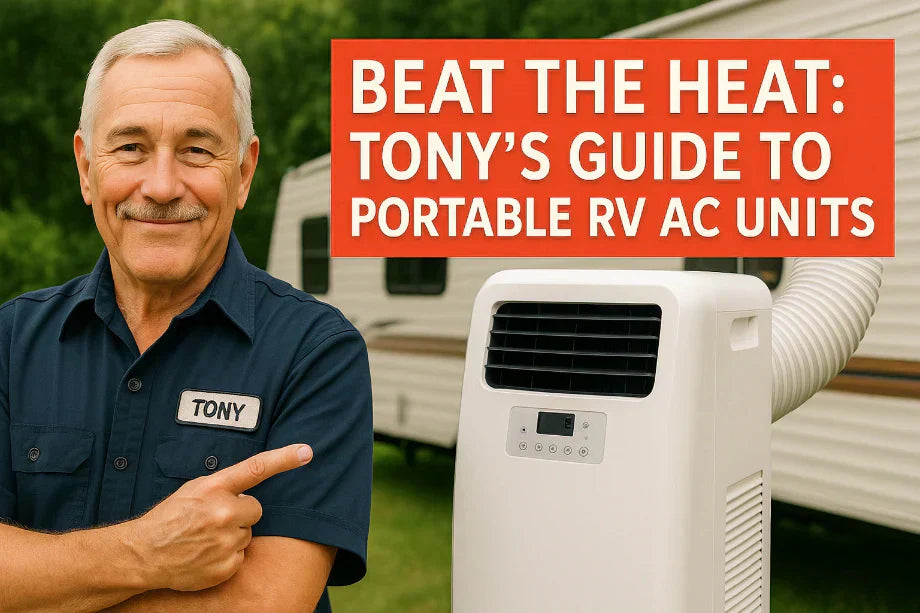🌞 Stay Cool on the Road
Hey folks, Tony the Trusted Tech here! 👋
If you're like me, you love hitting the open road in your RV. But when summer arrives and temperatures soar, keeping your RV’s interior comfortable can be a real challenge. That’s where portable RV air conditioning units save the day. These compact, mobile cooling units make it easy to beat the heat, no matter where your adventure takes you.
Today, I’ll walk you through the essentials: why you might want a portable RV AC, what features to look for, and how to pick the best one for your rig. Whether you’re a seasoned RVer or new to the scene, this guide will help you stay comfortable and safe during your summer trips.
❄️ Why Choose a Portable RV Air Conditioner?
When it comes to cooling your RV, you have options. You can install a roof-mounted AC, upgrade your central unit—or, for many people, a portable RV air conditioning unit is the easiest and most versatile solution.
Here’s why:
✅ Easy Installation: No special tools required. Just plug it in, attach the exhaust hose, and you’re ready to cool.
✅ Flexibility: Move it between rooms or use it in different vehicles.
✅ Affordability: A fraction of the cost of a built-in unit.
✅ Energy Efficiency: Focus cooling where you need it.
According to the DOE, focusing cooling efforts can save significant energy compared to cooling an entire RV.
👀 What to Look for in a Portable RV AC
With so many options, making a decision can be overwhelming. Here are the essentials
🌡️ Cooling Capacity (BTUs)
With so many options out there, it’s easy to feel overwhelmed when choosing the best portable RV air conditioner. Here are the essentials you need to consider:
-
✅ 5,000–7,000 BTUs: Ideal for small campers or van conversions.
-
✅ 8,000–12,000 BTUs: Works well for medium-sized RVs.
-
✅ 12,000–14,000 BTUs: Best for larger RVs and motorhomes.
Remember, the more BTUs a unit has, the more cooling power it can deliver. Choosing the right BTU rating is crucial for keeping your space comfortable and making sure your AC doesn’t work too hard—or too little—for the area you want to cool.
If you want to drill down even further into BTUs and how to match an air conditioner to your space, I highly recommend checking out this helpful guide from Pick HVAC for a detailed BTU-to-room-size chart and expert tips.
🔌 Power Source
Most portable RV AC units can run on 120V shore power, making them ideal for campgrounds. However, if you’re boondocking, you’ll want to consider:
-
A generator
-
A solar setup
-
A higher-capacity battery/inverter combination
For more guidance about RV electrical setups, visit RV Education 101 for expert tips.
💧 Moisture Management
Some units have built-in dehumidifiers, making them ideal for humid climates. Always verify if the AC can remove moisture effectively.
📏 Portability and Size
Measure your space before making a purchase. The best portable air conditioner for RV setups balance cooling capacity and compact design.
🛠️ Best Portable AC Units for RV Use
Here are some top picks based on efficiency, user-friendliness, and durability:
✅ Whynter ARC-14S — 14,000 BTUs, ideal for larger RV spaces.
✅ Black + Decker BPACT08WT — 8,000 BTUs, great for smaller spaces.
✅ SereneLife SLPAC10 — 10,000 BTUs, excellent for medium-sized campers.
✅ Honeywell MN10CESWW — 10,000 BTUs, highly efficient and reliable.
For more recommendations and reviews, I always refer to Consumer Reports for trusted, in-depth evaluations.
⚡️ Installing a Portable RV AC Unit: Simple Tips
Installation is straightforward if you follow these steps:
-
Choose the Location: Near a window for the exhaust.
-
Connect the Hose: Attach the exhaust tube and secure it.
-
Plug It In: Ensure you have the right voltage and breaker capacity.
-
Test the Unit: Run the AC and adjust the settings.
🌳 Maintaining Your Portable RV AC Unit
To keep your unit running smoothly:
✅ Clean the Filter: Wash it every two weeks during heavy use.
✅ Check the Exhaust Hose: Ensure it’s securely connected and free from obstructions.
✅ Inspect for Leaks: Watch for water accumulation and use a drainage pan if necessary.
✅ Store Properly: At the end of the season, wipe down the unit, remove water, and cover it.
🔥 Common Problems and Fixes
Even the best units can have issues. Here are quick solutions:
-
Unit Not Cooling: Check the filter and compressor.
-
Excessive Noise: Ensure the unit is level and on a stable surface.
-
Unit Leaking: Confirm the drainage is working correctly.
💭 Final Thoughts from Tony
There you have it, friends — everything you need to know about choosing and using a portable RV AC. Stay comfortable, stay safe, and make the most of every adventure. Remember, it doesn’t matter if you’re tackling summer in a tiny camper or a massive motorhome — with the right equipment, you can enjoy the open road in comfort.
If you’re ready to upgrade your mobile cooling solution, don’t forget to revisit the Complete Guide to a 2.5 Ton Air Conditioner for more air conditioning tips that work at home and on the move.
Until next time, this is Tony the Trusted Tech signing off — stay cool, stay safe, and happy RVing! 🌞







